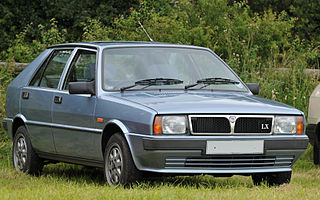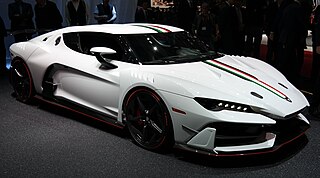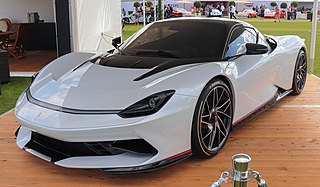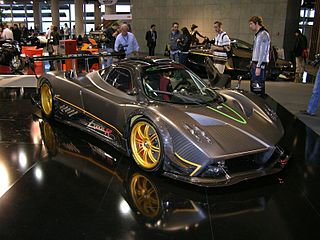
Lancia Automobiles S.p.A. is an Italian car manufacturer and a subsidiary of Stellantis Europe, which is the European subsidiary of Stellantis. The present legal entity of Lancia was formed in January 2007 when its corporate parent reorganised its businesses, but its history is traced back to Lancia & C., a manufacturing concern founded in 1906 in Torino by Vincenzo Lancia (1881–1937) and Claudio Fogolin. It became part of Fiat in 1969.

The Lancia Delta is a small family car produced by Italian automobile manufacturer Lancia in three generations. The first generation (1979–1994) debuted at the 1979 Frankfurt Motor Show, the second generation (1993-1999) debuted at the 1993 Geneva Motor Show, and the third generation (2008–2014) debuted at 2008 Geneva Motor Show.

The Mitsubishi Lancer Evolution, popularly referred to as the 'Evo', is a sports sedan and rally car based on the Lancer that was manufactured by Japanese manufacturer Mitsubishi Motors from 1992 until 2016. There have been ten official versions to date, and the designation of each model is most commonly a Roman numeral. All generations use two-litre intercooled turbo inline four-cylinder engines and all-wheel drive systems.

The Lancia Stratos HF, known as Lancia Stratos, is a rear mid-engined sports car designed for rallying, made by Italian car manufacturer Lancia. It was highly successful in competition, winning the World Rally Championship in 1974, 1975 and 1976; as well as winning the 1974 Targa Florio, winning the Tour de France Automobile five times and the Giro d'Italia automobilistico three times.

The Bugatti EB 110 is a mid-engine sports car initially conceived by Paolo Stanzani in the mid 1980s and produced by Bugatti Automobili S.p.A. from 1991 until 1995, when the company was liquidated. The model restarted the brand's presence in the automobile industry after a hiatus of nearly 40 years.

The Pagani Zonda is a mid-engine sports car produced by Italian sports car manufacturer Pagani. It debuted at the 1999 Geneva Motor Show. Produced on commission in limited units, as of 2019 a total of 140 cars had been built, including development mules. Variants include a 2-door coupé and roadster variant, along with a third new variant being the barchetta. Construction is mainly of carbon fibre.

The Lancia Fulvia is a car produced by Lancia between 1963 and 1976. Named after Via Fulvia, the Roman road leading from Tortona to Turin, it was introduced at the Geneva Motor Show in 1963 and manufactured in three variants: Berlina 4-door saloon, 2-door Coupé, and Sport, an alternative fastback coupé designed and built by Zagato on the Coupé floorpan.

The Lancia Delta S4 is a Group B rally car manufactured by the Italian car company Lancia. The Delta S4 competed in the World Rally Championship in 1985 and 1986, until Group B class was disbanded and the cars were eventually banned from competition completely by European sanctioning body FIA. The car replaced, and was an evolution of, the 037. The S4 took full advantage of the Group B regulations, and featured a midship-mounted engine and all-wheel drive for superior traction on loose surfaces.

The Lancia Montecarlo is a Pininfarina-designed two-seater, mid-engined sports car manufactured and marketed by Lancia in Italy for model years 1975-1981, across two series.
The B Engineering Edonis is a sports car developed in the year 2000 and manufactured by Italian automobile manufacturer B Engineering with overall engineering by Nicola Materazzi and styling by Marc Deschamps.

The Lancia Rally was a mid-engine sports car and rally car built by Lancia in the early 1980s to compete in the FIA Group B World Rally Championship. Driven by Markku Alén, Attilio Bettega, and Walter Röhrl, the car won Lancia the manufacturers' world championship in the 1983 season. It was the last rear-wheel drive car to win the WRC.

Bugatti Automobiles S.A.S. is a French luxury sports car manufacturer. The company was founded in 1998 as a subsidiary of the Volkswagen Group and is based in Molsheim, Alsace, France. The company makes a variety of two-seater and track-only cars.

The Ferrari GTO is an exotic homologation version of the Ferrari 308 GTB produced from 1984 until 1987 in Ferrari's Maranello factory. It was designated GT for Gran Turismo and O for Omologata.

The Lancia Trikappa is an automobile produced by Lancia between 1922 and 1925. It was a luxury car, offered as the flagship of Lancia's production. The Trikappa 4.5-litre V8 is notable as the first of Lancia's narrow V engines, a distinguishing feature the manufacturer only abandoned in the 1970s. The car was offered as a bare rolling chassis, as torpedo or 6-seater coupé de ville. In total 847 were manufactured.

The Rimac Concept One, sometimes stylized as Concept_One, is a two-seat high-performance electric car designed and manufactured in Croatia by Rimac Automobili. With a total output of 913 kW and an acceleration time from 0–100 km/h (0–62 mph) in 2.5 seconds, the Rimac Concept One was claimed to be the world's fastest accelerating electric vehicle in 2013.

The Lamborghini Huracán is a sports car manufactured by Italian automotive manufacturer Lamborghini replacing the previous V10 offering, the Gallardo. The Huracán was revealed online in December 2013, making its worldwide debut at the 2014 Geneva Auto Show and was released in the market in the second quarter of 2014.

The Italdesign Zerouno is a sports car produced by Italian automotive styling house Italdesign Giugiaro and was introduced in 2017. The Zerouno is the first car sold under the name of the Moncalieri design house and was created by their Italdesign Automobili Speciali division. The name means "Zero One", as it is the first production vehicle from Italdesign's low production sports car division, Italdesign Automobili Speciali.

The Pininfarina Battista is an electric performance car manufactured by Automobili Pininfarina GmbH which is headquartered in Munich, Germany, with roots in the Italian car design firm and coachbuilder Pininfarina. The name Battista is a tribute to Pininfarina's founder Battista Pininfarina. The car was publicly unveiled at the 2019 Geneva Motor Show. It is the first Pininfarina-branded car and is also featured in the popular racing game Asphalt Legends Unite, while the "Anniversario" edition is featured in Asphalt 8: Airborne.

The Pagani Zonda R is a track day car developed and manufactured by Italian sports car manufacturer Pagani. It debuted at the 2007 Geneva Motor Show, using the 6.0-litre GT 112 engine sourced from the racing version of the Mercedes-Benz CLK-GTR. The Zonda R's competition lies with track-based cars, such as the Ferrari FXX and Maserati MC12 Corse rather than the original Zonda's road competitors as it is not road-legal.
Sergio Limone is an Italian automobile engineer. He has carried out numerous sports car projects for the Fiat Group, including the Lancia Rally 037, Lancia Delta S4 and Lancia Delta for FIA World Rally Championship, and the Alfa Romeo 155 and Alfa Romeo 156 Touring cars.




















